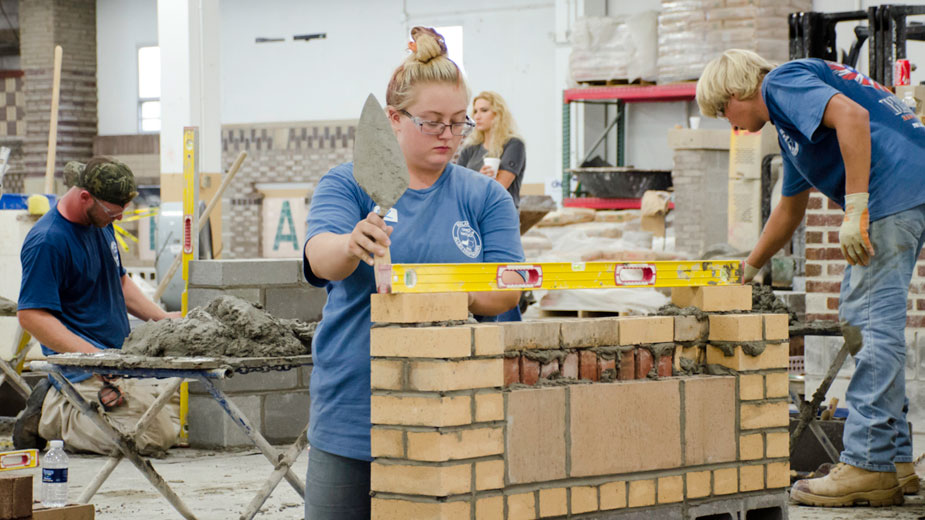Skilled Trades Keep Training Future Workforce During Pandemic
YOUNGSTOWN, Ohio – Between an uphill battle of overcoming the “dirty job” stereotype and finding skilled workers who can pass a drug test, conditions were challenging for the building trades before the coronavirus pandemic.
As states issued stay-at-home orders amid rising diagnoses of COVID-19, the disease spread by the coronavirus, trade unions still worked to recruit and train workers to do the jobs that filled their schedules before the pandemic. Social distancing restrictions created new challenges to accomplish that, union leaders say.
Restrictions all but prevent in-person interviews and testing for recruits. Through March, Local 8 of the Bricklayers and Allied Craftworkers union, Youngstown, typically coordinated with the Builders Association of Eastern Ohio and Western Pennsylvania to conduct apprentice interviews, says its field representative, Brian Collier.
The Bricklayers took applications for three weeks, but couldn’t do any testing or interviews, which set them back, Collier says. The union received only eight applicants this year, down from an average of 20 annually when he began his job six years ago.
Typically, applicants who are accepted get sent to the union’s training center in Amherst for a five-week preapprenticeship program. “We were not able to do that this year, mostly because the training center was closed for several weeks,” Collier says.
Now that the center has reopened, staff there has to finish with other apprentices whose training was interrupted by the coronavirus. “They’re jammed up and can’t do that preapprenticeship,” he says. Although preapprenticeship training isn’t required to put apprentices in the field, forgoing it this year will be a “tough decision” for the union, he says.
But as work ramps up regionally, contractors will want these students, says Don Mays, field representative for Local 10 of the Bricklayers and Allied Craftworkers, East Liverpool. If a contractor says he’ll hire an apprentice, “I don’t have time for that training,” he says. Putting them in the field gets them familiar with how job sites work and helps the union to weed out the apprentices who aren’t a good fit.
“They do a little bit of grunt work, if you will,” Mays says. “They learn to get a little bit of dirt on them, a little bit of sweat. And we figure out pretty quick if they like it or they don’t like it.”
The pandemic has forced some training centers to retool to meet safety standards set by the state, the Occupational Safety and Health Administration and the Centers for Disease Control and Prevention, says Tony DiTommaso Jr., president of Local 171 of the United Brotherhood of Carpenters & Joiners of America and secretary/treasurer of the Western Reserve Building Trades.
Instead of having four classes of 16 students, the Carpenters training center in Richfield is holding six classes of 10 students and spacing them throughout the building. Staggered breaks and lunch periods are taken in students’ vehicles. And the break room is closed.
“That’s what it’s about. The safety – the safety of members, the safety of the job site, the safety of tomorrow’s workforce,” DiTommaso says. “You have to ingrain this into apprentices now. We want everyone to go home in the same shape that they got here in.”
Local 396 of the Plumbers & Pipefitters union interviewed 33 of its 150 applicants before the pandemic put testing plans in April on hold, says its training director, Rick Boyarko. Testing is rescheduled for June 15 and 16 with 10 apprentices at a time, he says. Another round of interviews is scheduled for July.
To limit contact, the union staggered interview and testing times, says Marty Loney, business agent for Local 396. And although the union has some testing equipment on hand, “potential candidates know that they have to bring certain things with them,” he says.
As with other training centers, class sizes are reduced, although some disciplines lend themselves to social distancing. Welding is “naturally isolated because you’re in a weld booth that’s surrounded by bricks and there’s a big curtain in front of you.” Students wear masks and gloves the entire time, Boyarko says. “So that was an easy one to get started back up.”
When work in the classroom resumes in the fall, Boyarko expects changes based on any new regulations from the state. “We’ll comply with whatever they want us to,” he says.
Meanwhile, recruitment and training aren’t the only challenges exacerbated by the pandemic.
As some projects slowed, unions were forced to lay off apprentices working on the jobs, Boyarko says. While a few contractors who received government assistance were able to keep some apprentices on the payroll, Local 396 had to lay off 25 apprentices – about half – and hasn’t been able to bring them all back yet.
That also prevents the union from bringing on new apprentices until it has someplace to put people who were laid off, he says, potentially setting recruitment back three to four months.
“With upcoming work in the area, we’re hoping demand will be there in July and August,” Boyarko says. “I still have apprentices who haven’t gotten a paycheck since the middle of March.”
If there’s a silver lining, it’s that the skilled trades still had work to do during the shutdown while other occupations saw all workers get laid off or furloughed, he says. Even during stay-at-home orders, customers needed to maintain their heating, cooling and plumbing systems.
“So no matter what, we have to stay working,” Boyarko says. “When I do recruitment, I can say we are an essential business.”
All 420 members of the Laborers’ International Union Local 125 are back working, says business manager Rocky DiGennaro.
“If I had another 50 laborers, I could put them out to work,” he says. “These jobs are going unfilled every day. We’re talking about good honest work.”
In northeastern Ohio, the average age of a laborer is 49, DiGennaro says. When it comes to recruiting younger workers, the challenges are the same as they were before the pandemic: finding people who want to do the work, he says.
“These guys are young,” he says. “They think they’re entitled to something they’re not entitled to.”
And while unions typically target students coming out of high school or about to graduate, he says it’s the apprentices in their 20s and 30s “who are going to push us across the finish line.” Regardless of the age, applicants need marketable skills, particularly a strong background in math, including calculus and geometry, he says.
The trades are working to change the narrative that only students who won’t make it through college should go into the trades. During a recent career fair, the Bricklayers’ Collier says he met a guidance counselor who told him she directs students who underperform in academics to skilled labor.
“Everything we do is mathematically based,” Collier says. “Those students have a hard time getting through these trade apprenticeships.”
“We need people who have scholastic skills,” the union’s Mays agrees. “Those are the people we want first.”
The trades still tout the benefits of a career in skilled labor, including health coverage, retirement and the opportunity to work up to making six-figures annually.
Union leaders agree that awareness efforts over the last five or so years – including last year’s inaugural Mahoning Valley Skilled Trades Expo, which brought in more than 4,000 students from five counties – make apprenticeships “a bit more popular conversation around the family table,” says the Carpenters’ DiTommaso.
The unions had hoped to build on that momentum with another expo this year. And while the event is still scheduled for the fall, they await guidelines from the state.
Membership and apprentice numbers for Carpenters Local 171 are increasing, DiTommaso says. “We’re bringing in a couple apprentices every month.”
Currently, the union has about 100 apprentices and the number is “steadily increasing” compared to four years ago.
“We usually have anywhere from 65 to 75 apprentices in the program,” he says. “And now we’re up in the hundreds.”
The union’s apprentice training center in Richfield is looking to enclose an outdoor pavilion on its campus for more classroom or work space, DiTommaso notes.
As recruitment improves, so does retention, he adds. In years past, it was common for the carpenters to retain 40% to 60% of apprentices. But through mentorship of the new apprentices, the carpenters are seeing retention numbers improve.
“Our local has kept 86% of its apprentices in the past couple of years,” DiTommaso says. “We’ve been working hard to mentor those guys.”
Union business agents visit classes monthly to introduce themselves to the apprentices and answer questions. Some fourth-year apprentices also mentor the first-year students. It’s more than DiTommaso recalls being done when he was an apprentice. Today it takes more effort to keep students on track because they need more than a good paycheck – they need job satisfaction, he explains.
“Some of them are 18 and don’t know what they’re going to do,” he says. “How many kids come out of school and shoot at the target and hit it dead center?”
Skilled trades unions realize they must spend more money on marketing, says the Bricklayers’ Mays. Geofencing and Facebook ads help him reach more prospects, he adds.
When recruiting, Mays meets with prospective apprentices two or three times before the actual interview. But COVID-19 has “greatly restricted our ability to mobilize for our apprentices,” he says.
Pictured: Desiray Adams, a masonry apprentice, works at the Bricklayers and Allied Craftworkers training center in Amherst.
Copyright 2024 The Business Journal, Youngstown, Ohio.



